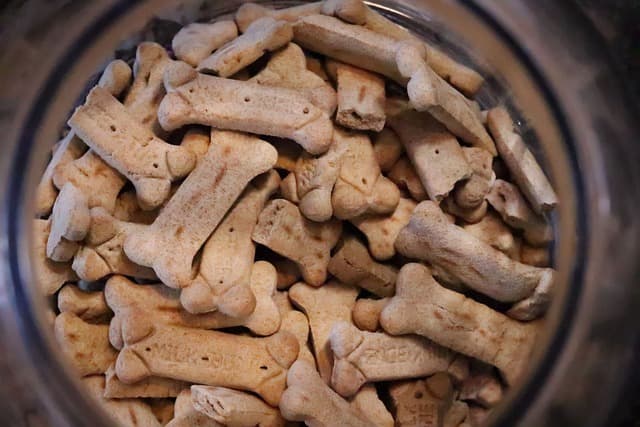What to feed your dog, dry food or “natural” is the answer here!
Today, most dog owners and breeders give preference to dry food of industrial production. There are several reasons for this:
- Convenience of feeding.
- Balanced diet, which is guaranteed by manufacturers.
Naturally, these requirements are met in the production of premium and holistic feeds, the reputation of which is constantly confirmed by modern innovations and the latest developments.
In addition, there are situations when you can’t do without dry food: food allergies, diseases of internal organs. Then dietary feeds come to the rescue, with the help of which you can avoid skin rashes in the animal or put the disease in remission.
Animals who are overweight or have a disturbed metabolism also need diet feeds. Otherwise, it is impossible to reduce the caloric content of the diet while retaining nutrients.
A balanced diet is very important for pregnant females and cubs during the growth period. Almost every line of dry food has diets that meet the needs of these two groups of animals.
It is difficult to raise a real show dog or cat on natural food: a large volume of food, which is characterized by “natural”, leads to an increase in the volume of the stomach and, accordingly, sagging belly. This spoils the exterior of the animal, and therefore reduces its chances of winning.
In addition, special additives, included in the composition of dry food, improve the appearance of the pet’s coat, add brightness to the color and eliminate dandruff and brittle hair. A bag of dry food is very convenient to take with you to the show.
What is “natural” feeding?
Natural food is so called because it consists of familiar, familiar products, the benefits of which we do not doubt. Owners who give preference to natural products are ready to feed their pet with steamed meat, cottage cheese and vegetables without nitrates and herbicides. Such a diet is certainly very useful. But supporters of natural nutrition forget that an animal is not a human being: its needs and desires are different.
First of all, dogs do not need a variety of diet. Features of their digestion are such that the more monotonous and familiar will be consumed food, the easier and more complete it will be digested by the GI tract. Therefore, it is more important for the animal a certain set of vitamins and trace elements that come with nutrition.
The human body, experiencing a deficiency in a nutrient component, signals this with an increased appetite, manifested towards foods containing the missing ingredient.
Unfortunately, a dog will not tell us what it wants to eat, so the owner’s task is to make the most balanced diet that meets the pet’s needs for essential nutrients. It is very difficult to do it at home, because it is impossible to calculate the exact dose of proteins, fats and carbohydrates necessary for the full life of the pet, especially to know the chemical composition of products. Therefore, most owners try to determine “by eye” what the animal’s body needs and how to meet its needs.
Fans of natural food should also know that due to the specific metabolism, dogs are unusually sensitive to all kinds of fertilizers, additives and gene modifiers. To keep your pet healthy, the food should be truly natural. Ideally, grown and produced in-house. Then the benefits will be really obvious. If you do not have the opportunity to determine the quality of the components of the diet, it is better to transfer the pet to dry food.
If you still decide to give preference to natural food, try to fulfill the following requirements:
- Food should be of high quality and grown only with the use of natural fertilizers and fertilizers.
- The animal should receive an additional vitamin complex every day, satisfying its needs in vital trace elements.
- Feeding should be fractional, divided into 3-4 meals.
- The temperature of the food should be 25-35 °C.
- Financial possibilities and time should allow you to prepare a balanced diet according to all rules of nutrition.
The following foods should not be given when feeding “natural” food:
- scraps from the human table.
- Salty, spicy, fried foods.
- Any bones, they can traumatize the walls of the stomach or lead to intestinal obstruction.
There is also such a thing as mixed feeding
- Feed and porridge in one feeding;
- Feed in the morning and gruel in the evening;
- Feed one month, porridge the next;
- Feed meat (vegetables, fermented milk) without porridge in one bowl.
This is not good for the animal’s health, as the body needs different enzymes and amounts of acid to digest porridge and dry food. Feeding dry food and meat often gives an excess of protein, excess phosphorus, lack of calcium – as a result of this can develop rickets, accelerated growth with protein will give problems with joints, and in older age can develop urolithiasis with the formation of phosphate and kidney failure. Feeding dogs straight food in the morning and food in the evening (or vice versa) is unacceptable. There is a very heavy load on the GI tract and on the liver in particular. In dogs with this type of feeding is almost always found in coprology fatty acids, iodophilic flora, even neutral fats – an indicator of improper work of the pancreas. Problems with the gallbladder are also often detected. To work well, the GI tract must produce a certain type of enzymes and bacteria for 5-7 days. That’s why manufacturers of ready-made feeds always recommend a gradual transition to a new feed. And when the type of feeding changes twice a day, the body is simply “off the scale”. In the morning he (the body) received information on the production of enzymes for porridge, in the evening he is told: “No, let’s go to dry food”.
As for wet food, it is recommended to give it 1-2 times a week, or even less often, replacing one feeding. It is desirable that they were feeds of the same brand. It is possible to mix wet food and natural food both in one feeding and separately.



